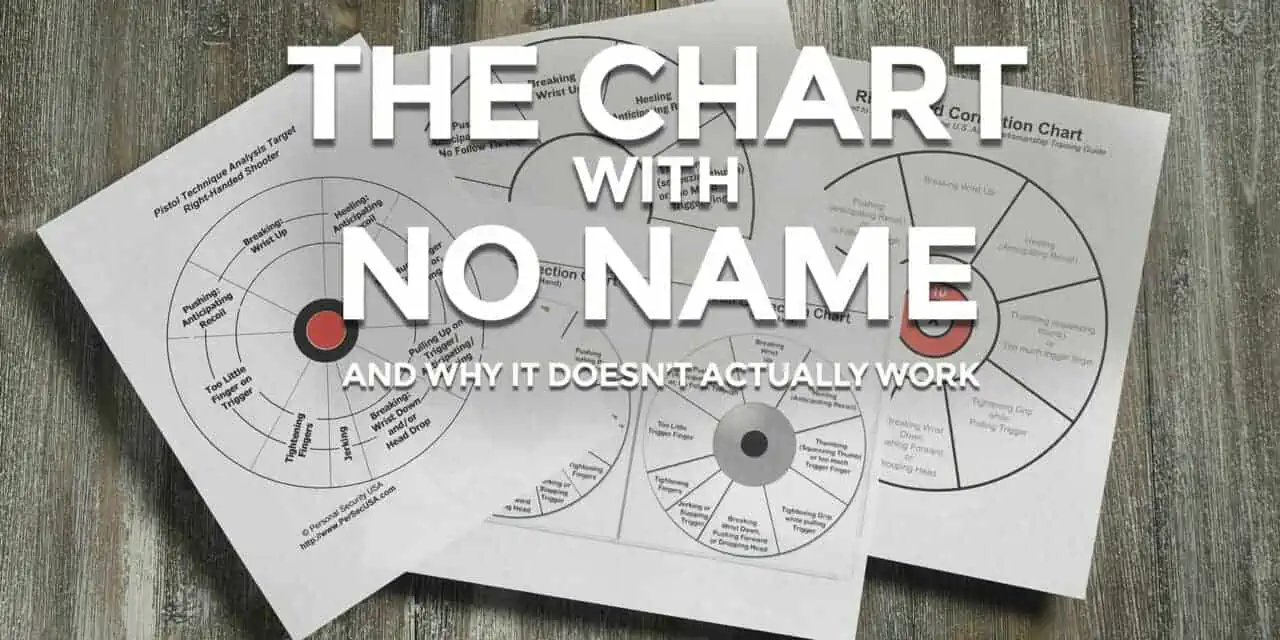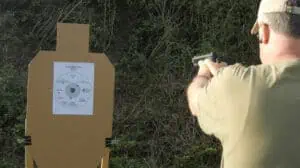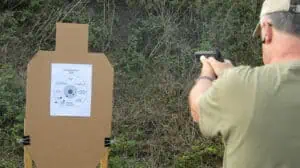Tracing The Origins Of A Common Pistol Shooting Grip Chart
There comes a point in your marksmanship journey where you really want to get better. You want to not only shoot AT the target, but hit it as well. You take some classes. Dry fire training comes into play. You want to improve your accuracy, but you’re not 100% certain on how to do it. Chances are, you’ll run into this ubiquitous pistol shooting grip chart online or at your local range. You look at it, and you start to think it might help you diagnose your shooting and help you improve.
And you’d be wrong. That chart (and variations of it) have been around for decades, but it’s never been proven to be effective. It is not used by any of the major shooting schools. The reasons for how it came to be and why it still exists are a bit of a mystery. We’ll talk about those mysteries in a bit, but first, let’s talk about the problems of pistol marksmanship. This will show us why this chart is close to useless for improving your pistol skills.
Where Did This Chart Come From?
The chart itself has been around for as long as I can remember. I reached out to noted firearms trainer Karl Rehn to find out how this came into being. Rehn is not only a firearms trainer, he’s also an authority of the history of firearms training itself. As such, he’s the perfect person to help us find out the origins of this pistol shooting grip chart.
“I don’t know the exact origin of that chart,” Rehn said, “and I’m not sure anyone does. According to some of the trainers I know, who have been around for years and years, that chart has been with us since at least the 1960’s. Nobody can find it in any shooting book. No one from bullseye, defensive or competition shooting or LEO training ever thought much of it. In fact, it may have been created by a target printing company.”
“If it did come from around the late 50’s/early 60’s,” Rehn continued, “bullseye competitions were the only thing going on then. That time pre-dates competitions such as IPSC and based on its design, it is unlikely to have come from PPC (Police Pistol Competitions).”
Apparently Nobody Owns The Pistol Shooting Grip Chart
“There are many different versions of it out there right now,” Rehn went on to say, “which are produced by many different vendors. However, no one has stepped up to claim a copyright on the chart itself. Given that the chart doesn’t show up in any handgun training book from any era (and I’ve looked at almost 300 of them), I would say it was never widely used in an effective way. This makes me think it was dreamed up by a target printing company or something similar, a company which now either doesn’t care about the copyright to the chart, or has since gone out of business and has lost the copyright.”
So even if the chart was created by somebody who knew what they were doing, does it actually help improve your shooting? As we’ve said in the past, the #1 problem with pistol marksmanship is trigger control. Pressing the trigger is the last thing you do before the gun goes bang and the bullet flies downrange. Therefore, any mistakes made while pressing the trigger will affect your accuracy more than other actions involved in firing your pistol. You can have a perfect stance, a perfect grip, and a perfect sight alignment and sight picture. However, if you pull the trigger too sharply, you’re going to miss.
It’s Not A Useful Training Tool
As a result, the one area of the commonly-used pistol shooting grip chart that is actually useful is the “Jerking The Trigger” slice that occupies the lower left corner of the pie chart. The rest? Well, if your sights aren’t properly lined up, you’re going to be all over the place on the chart. If you’re flinching or anticipating recoil, that might show up as shots landing on the lower portion of the chart. However, shots can also hit there if your sight alignment is off, or the sights on your gun are not set up properly. My experience and my time on the range with new shooters has shown me that spending a few moments looking at how their pistol moves as they take a shot (or having them record themselves shooting a gun) will tell me more about where they need improvement than any sheet of paper ever will.
So why is this pistol grip chart so popular? To be honest, it may be because it looks like a shortcut. At first glance, it looks like an easy way to quickly get better with your pistol of choice. However, the problem with most new pistol owners isn’t that they have a specific issue such as too much (or too little) finger on the trigger or something similar. Rather, their problem is consistency. They are not shooting groups, which would show what they are doing wrong (or right) on the target. Rather, their shots are all over place, never landing in one particular area or forming a definable group. Taking the time to learn consistent performance should come first, and leave the gimmicky and ineffective training charts in the past, where they belong.




